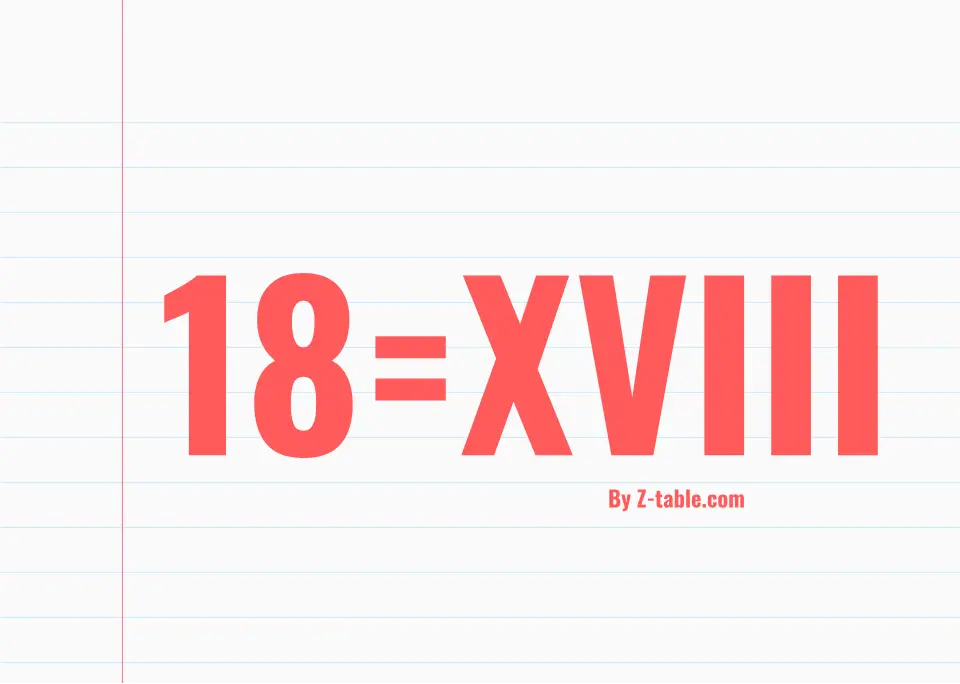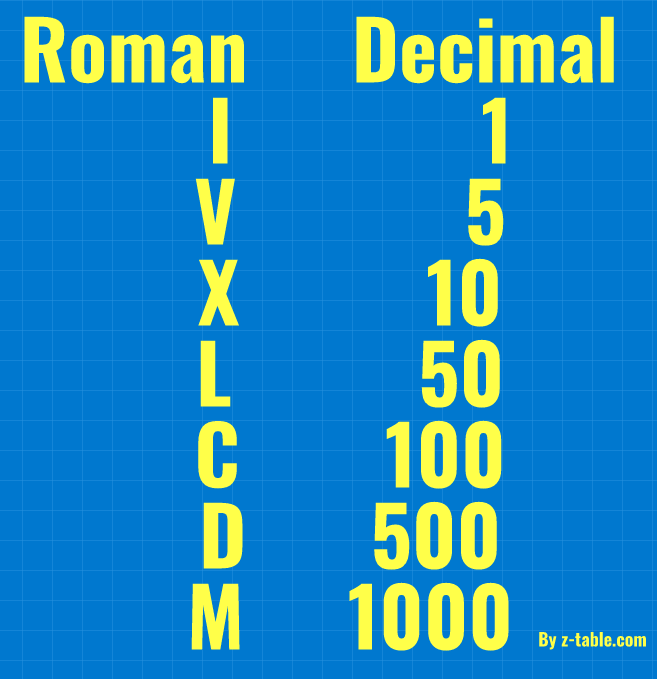What is XVIII Roman Numerals?
XVIII is a Roman numeral that represents the number 18 in Arabic numerals. It is composed of the Roman numeral symbols X (10) and VIII (8). By combining these symbols, XVIII is formed, signifying 10 + 8 = 18. In this article, we will explore the composition, principles, and trivia related to XVIII in Roman numerals. Sometimes conversion of Roman Numerals can be a daunting task, especially for larger numbers. You can always use a Roman numerals converter if you need to quickly convert Roman numerals to decimal numbers .
Composing XVIII in Roman Numerals
To express XVIII in Roman numerals, the larger numeral X (10) is followed by the smaller numeral VIII (8), indicating addition. The combination results in XVIII, representing the number 18.
| Roman Numeral | Value |
|---|---|
| I | 1 |
| V | 5 |
| X | 10 |
| L | 50 |
| C | 100 |
| D | 500 |
| M | 1000 |
Key Principles for Writing Roman Numerals
Understanding the key principles for writing Roman numerals is important for correctly composing and interpreting them. Here are the principles to keep in mind when representing the number XVIII (18) in Roman numerals:
1. Addition: A larger numeral preceding a smaller numeral denotes their values being added together. For example, X + VIII = 10 + 8 = 18.
2. Subtraction: A smaller numeral before a larger numeral indicates that the smaller value is subtracted from the larger value. However, XVIII does not involve subtraction, as it represents a direct value of 18.
3. Repetition: A numeral can be repeated up to three times to represent the sum of its value. For instance, III represents 1 + 1 + 1 = 3. However, XVIII does not involve repetition, as it represents a specific value of 18.
4. Limit on Repeating: A numeral should not be repeated more than three times consecutively. For example, 4 is represented as IV (5 - 1), not IIII.
1. Addition: A larger numeral preceding a smaller numeral denotes their values being added together. For example, X + VIII = 10 + 8 = 18.
2. Subtraction: A smaller numeral before a larger numeral indicates that the smaller value is subtracted from the larger value. However, XVIII does not involve subtraction, as it represents a direct value of 18.
3. Repetition: A numeral can be repeated up to three times to represent the sum of its value. For instance, III represents 1 + 1 + 1 = 3. However, XVIII does not involve repetition, as it represents a specific value of 18.
4. Limit on Repeating: A numeral should not be repeated more than three times consecutively. For example, 4 is represented as IV (5 - 1), not IIII.
Numbers Related to XVIII in Roman Numerals
Roman numerals encompass the letters I, V, X, L, C, D, and M, used to represent various numbers. The numerals related to XVIII and its neighboring values are as follows:
- XVII = 17
- XVIII = 18
- XIX = 19
- XX = 20
- XXI = 21
- XXII = 22
XVIII Roman Numerals Trivia
Here are some interesting facts and trivia about XVIII:
- The number 18 is significant in various cultures and contexts. In Judaism, the number 18 symbolizes "chai," which means "life." It is considered a spiritual and fortunate number.
- XVIII is associated with the 18th element in the periodic table, argon (Ar). Argon is a noble gas widely used in various applications, including lighting and welding.
- In sports, XVIII is noteworthy as it represents the 18th edition of the FIFA World Cup held in 1934. This international football tournament is celebrated globally and showcases the best national teams competing for the prestigious trophy.
Problem Examples for XVIII Roman Numerals
Here are a few examples of Roman numeral conversion problems involving XVIII:
Addition: XVIII + V = ?
Adding the value of V (5) to XVIII (18), we get XVIII + V = 18 + 5 = 23.
Subtraction: XVIII - IX = ?
Subtracting the value of IX (9) from XVIII (18), we get XVIII - IX = 18 - 9 = 9.
Multiplication: XVIII * III = ?
Multiplying the value of XVIII (18) by III (3), we get XVIII * III = 18 * 3 = 54.
Division: XVIII / II = ?
Dividing the value of XVIII (18) by II (2), we get XVIII / II = 18 / 2 = 9.
These examples illustrate the application of arithmetic operations using XVIII Roman numerals.
Addition: XVIII + V = ?
Adding the value of V (5) to XVIII (18), we get XVIII + V = 18 + 5 = 23.
Subtraction: XVIII - IX = ?
Subtracting the value of IX (9) from XVIII (18), we get XVIII - IX = 18 - 9 = 9.
Multiplication: XVIII * III = ?
Multiplying the value of XVIII (18) by III (3), we get XVIII * III = 18 * 3 = 54.
Division: XVIII / II = ?
Dividing the value of XVIII (18) by II (2), we get XVIII / II = 18 / 2 = 9.
These examples illustrate the application of arithmetic operations using XVIII Roman numerals.
XVIII Roman Numerals FAQs
Here are some frequently asked questions about XVIII Roman numerals:
How is XVIII written in lowercase Roman numerals?
In lowercase Roman numerals, XVIII is written as xviii.
Can XVIII be represented by any other combination of Roman numerals?
No, XVIII is unique and cannot be represented by any other combination of Roman numerals.
How do you write 18 in Roman numerals?
The Roman numeral for 18 is XVIII.
What is the value of XVIII in Arabic decimal numbers?
The value of XVIII in Arabic decimal numbers is 18.
Is there a quick and easy way to convert XVIII to a decimal number?
Yes, the quick and easy way to convert XVIII to a decimal number is to understand that it represents 18 directly without the need for any calculations.
How is XVIII written in lowercase Roman numerals?
In lowercase Roman numerals, XVIII is written as xviii.
Can XVIII be represented by any other combination of Roman numerals?
No, XVIII is unique and cannot be represented by any other combination of Roman numerals.
How do you write 18 in Roman numerals?
The Roman numeral for 18 is XVIII.
What is the value of XVIII in Arabic decimal numbers?
The value of XVIII in Arabic decimal numbers is 18.
Is there a quick and easy way to convert XVIII to a decimal number?
Yes, the quick and easy way to convert XVIII to a decimal number is to understand that it represents 18 directly without the need for any calculations.
XVIII is a Roman numeral that represents the number 18. It follows the principles of Roman numeral composition and has its own unique value and significance. Understanding the principles and trivia associated with XVIII enhances our understanding of this numeral system and its historical and cultural connections. To learn more about Roman numerals visit our comprehensive Roman numerals guide. For any other math and statistics related resources check out z-table.com.

